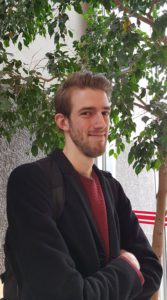So, this week I met with John Högström, 24 years old. He is one of our masterstudents at the Master Programme of ALM (Archive, Library and Museum studies). Since there are no students yet that can share their experiences of studying the master in digital humanities until next semester, I thought the next best thing was to hear out a student at our existing programme about the experience of being a student at the Department of ALM.
John and me meet up for the interview in the local cantina to have a conversation over some vegan pasta and blue cheese risotto. This is the place on campus where students go for lunch, for a coffee break or to just hang out or work on some study project.

John, at campus Engelska Parken
Within the ALM-domain, John is specializing in museum and heritage studies. Being on the second year of the two-year programme, he is busy writing his master’s thesis and simultaneously wrapping up a course in theories and methods for the ALM-field.
I start the interview by asking about his study background. Before entering master studies, John tells that he mixed studies in history and ethnology, among other subjects. “I came to the ALM-department a bit by chance. I actually started with master studies in history of science and ideas. But two weeks in, I realized I wanted something else and decided to quit. […] I applied for studies in museum and cultural heritage instead, and got accepted! With the class already two weeks far, it was a bit of a struggle at first but I managed to catch up pretty quickly.”
So, what is his ideas about the programme, I wonder. In comparison with his earlier student experiences, is there something special about ALM? “Well, I like the different variations of exam forms. The variety of having home exams, seminars, papers, group work….I like it. Another thing that is new to me but which makes the programme more exciting are that the department also has distant students [attending the Library- and Information Science track of the ALM Master Programme] and that some lectures are recorded.”
In addition to lectures and seminars, the programme offer other complements. “We also have had quite many field trips; visiting places like the Nordic Museum in Stockholm, or the museum storage of Upplandsmuseet (the Uppland county museum, my note) gives a good opportunity to talk to professionals in the field and grounded perspectives of the meaning of your studies. […] The five weeks of internship was one of my favorite parts of my museum studies. I spent them on the Nordic Museum, at the Department for Digital Interaction. It was so much to learn and I developed a lot. Much focus was on effective ways to spread research digitally and how to work with digital information in the organisation”
But John is clear with that he does not have to go outside of the classroom to get a wider perspective on things. “To have external lecturers are always exciting. It is important to get input from different people, in addition to the lecturers from the ALM-department.”
Compared to John’s previous experiences, he thinks the student base at the Master Programme of ALM is more mixed. “At the bachelor’s programme in history, most of the people were similar in age and interest. Here, there is definitely more variation. The mix of experiences, ages and academic background definitely makes the seminar discussions more dynamic and rich of different perspectives.”
This interview continues in part 2: Social Life.
